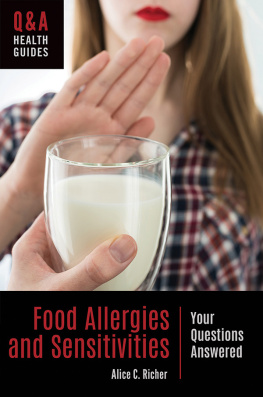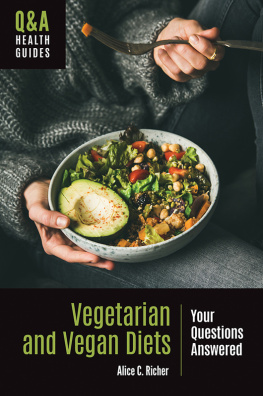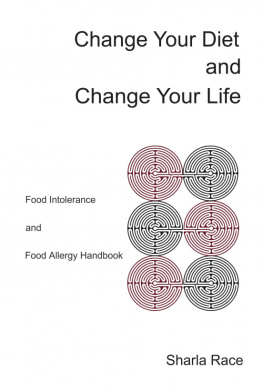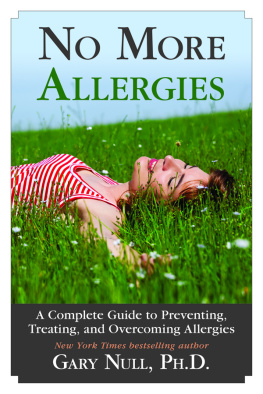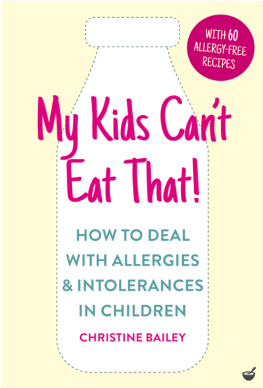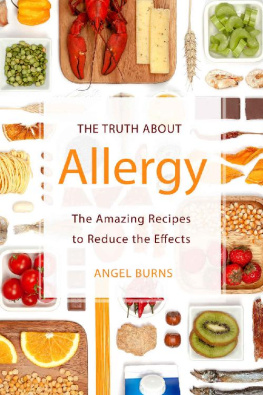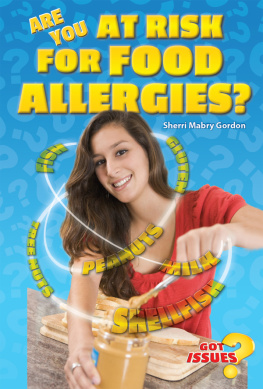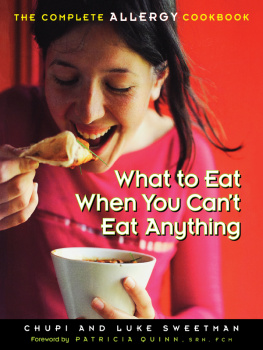Food Allergies and Sensitivities
Recent Titles in Q&A Health Guides
Self-Injury: Your Questions Answered
Romeo Vitelli
Living Green: Your Questions Answered
Amy Hackney Blackwell
Sexually Transmitted Diseases: Your Questions Answered
Paul Quinn
Mindfulness and Meditation: Your Questions Answered
Blaise Aguirre
Anxiety and Panic Disorders: Your Questions Answered
Daniel Zwillenberg
Substance Abuse: Your Questions Answered
Romeo Vitelli
Eating Disorders: Your Questions Answered
Justine J. Reel
Food Allergies and Sensitivities
Your Questions Answered
Alice C. Richer
Q&A Health Guides

Copyright 2019 by ABC-CLIO, LLC
All rights reserved. No part of this publication may be reproduced, stored in a retrieval system, or transmitted, in any form or by any means, electronic, mechanical, photocopying, recording, or otherwise, except for the inclusion of brief quotations in a review, without prior permission in writing from the publisher.
Library of Congress Cataloging-in-Publication Data
Names: Richer, Alice C., author.
Title: Food allergies and sensitivities : your questions answered / Alice C. Richer.
Description: Santa Barbara, California : ABC-CLIO, LLC/Greenwood, [2019] | Series: Q&A health guides | Includes bibliographical references and index.
Identifiers: LCCN 2018040017 (print) | LCCN 2018041380 (ebook) | ISBN 9781440856358 (ebook) | ISBN 9781440856341 (print : alk. paper)
Subjects: | MESH: Food Hypersensitivity | Food Intolerance
Classification: LCC RC596 (ebook) | LCC RC596 (print) | NLM WD 310 | DDC 616.97/5dc23
LC record available at https://lccn.loc.gov/2018040017
ISBN: 978-1-4408-5634-1 (print)
978-1-4408-5635-8 (ebook)
23 22 21 20 19 1 2 3 4 5
This book is also available as an eBook.
Greenwood
An Imprint of ABC-CLIO, LLC
ABC-CLIO, LLC
147 Castilian Drive
Santa Barbara, CA 93117
www.abc-clio.com
This book is printed on acid-free paper 
Manufactured in the United States of America
For Pete, Mike, and Dan, whose support is immeasurable. For Carrie and Lauren, who struggle with food allergies.
Contents
All of us have questions about our health. Is this normal? Should I be doing something differently? Whom should I talk to about my concerns?
And our modern world is full of answers. Thanks to the Internet, theres a wealth of information at our fingertips, from forums where people can share their personal experiences to Wikipedia articles to the full text of medical studies. But finding the right information can be an intimidating and difficult tasksome sources are written at too high a level, others have been oversimplified, while still others are heavily biased or simply inaccurate.
Q&A Health Guides address the needs of readers who want accurate, concise answers to their health questions, authored by reputable and objective experts, and written in clear and easy-to-understand language.
This series focuses on the topics that matter most to young adult readers, including various aspects of physical and emotional well-being as well as other components of a healthy lifestyle. These guides will also serve as a valuable tool for parents, school counselors, and others who may need to answer teens health questions.
All books in the series follow the same format to make finding information quick and easy. Each volume begins with an essay on health literacy and why it is so important when it comes to gathering and evaluating health information. Next, the top five myths and misconceptions that surround the topic are dispelled. The heart of each guide is a collection of questions and answers, organized thematically. A selection of five case studies provides real-world examples to illuminate key concepts. Rounding out each volume are a directory of resources, glossary, and index.
It is our hope that the books in this series will not only provide valuable information but will also help guide readers toward a lifetime of healthy decision making.
The number of people who struggle with food allergies, intolerances, and sensitivities has increased over the past few decades. The World Allergy Organization estimates that as of 2013 approximately 220250 million people worldwide struggled with at least one food allergy. The Food Allergy Research and Education organization reports childhood food allergies increased approximately 50 percent from 1977 through 2011 in the United States. Health-care providers worldwide also report increased cases of adverse food reactions.
Symptoms range from mild to chronically debilitating to life threatening, and the impact of them is significant, both personally and financially. The Americans with Disabilities Act of 1990 now includes those who live with adverse food reactions, and medical costs for the treatment of children in the United States with food allergies are an estimated $25 billion annually.
Although most people assume all food reactions are allergies, this is not the case. True food allergies involve the immune system and is frequently life threatening. An estimated 90 percent of food allergies worldwide are to eggs, cows milk, legumes (peanuts, beans), sesame seeds, shellfish, soy, tree nuts, and wheat. However, any food can cause an allergy in susceptible individuals. Food intolerances and sensitivities are distinguished from food allergies because they rarely involve the immune system, are often chronic and debilitating, and are thought to be the root cause for many chronic illnesses. It is yet to be determined exactly why an individual becomes allergic, intolerant, or sensitive to a food, but there are many different theories.
Current testing methods used to diagnose a food allergy or intolerance reaction have an estimated 5060 percent accuracy rate. However, testing methods for food sensitivities remain unreliable at best. Treatment options vary and are based on individual symptoms. Public health concerns are many regarding the safety of an allergic individual. One strategy to protect allergic individuals is to ban peanuts and tree nuts from public places. This has resulted in unintended consequences while also impacting those who do not have food allergies. Food safety laws have also been enacted to protect allergic individuals. Research on adverse food reactions has steadily increased since the 1970s and is ongoing in the areas of more accurate testing methods and new treatment methods.
The objective of this book is to provide information and education that help to easily distinguish between food allergies, food intolerances, and food sensitivities. It also answers the questions many people have about adverse food reactions, how to manage them, and reviews the most recent, accurate, scientific evidence available in an easy-to-understand format. How the medical community came to understand adverse food reactions is explored. Symptoms, treatment, and testing methods are discussed as well as the impact food allergies, intolerances, and sensitivities have on individuals and families. Support group information is provided along with a listing of resources for further information.
On her 13th birthday, Samantha was diagnosed with type 2 diabetes. She consulted her mom and her aunt, both of whom also have type 2 diabetes, and decided to go with their strategy of managing diabetes by taking insulin. As a result of participating in an after-school program at her middle school that focused on health literacy, she learned that she can help manage the level of glucose in her bloodstream by counting her carbohydrate intake, following a diabetic diet, and exercising regularly. But what exactly should she do? How does she keep track of her carbohydrate intake? What is a diabetic diet? How long should she exercise and what type of exercise should she do? Samantha is a visual learner, so she turned to her favorite source of media, YouTube, to answer these questions. She found videos from individuals around the world sharing their experiences and tips, doctors (or at least people who have Dr. in their YouTube channel names), government agencies such as the National Institutes of Health, and even video clips from cat lovers who have cats with diabetes. With guidance from the librarian and the health and science teachers at her school, she assessed the credibility of the information in these videos and even compared their suggestions to some of the print resources that she was able to find at her school library. Now, she knows exactly how to count her carbohydrate level, how to prepare and follow a diabetic diet, and how much (and what) exercise is needed daily. She intends to share her findings with her mom and her aunt, and now she wants to create a chart that summarizes what she has learned that she can share with her doctor.

